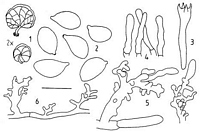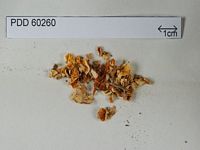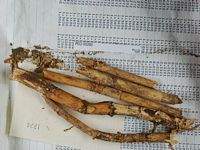|
 Campanella fimbriata Campanella fimbriata
BiostatusPresent in region - Indigenous. Endemic
Images (click to enlarge)
Caption: C. fimbriata. 1. Basidiomes (2x); 2, spores;
3, basidium; 4, cheilocystidia: 5, pileipellis elements; 6, caulocystidia. | 
Caption: Dried type specimen
Owner: Herb PDD | 
Caption: Dried type specimen
Owner: Herb PDD |
Article: Segedin, B.P. (1993). Studies in the Agaricales of New Zealand: some new and revised species of Campanella (Tricholomataceae: Collybieae). New Zealand Journal of Botany 31: 375-384 (http://www.rsnz.org/publish/abstracts.php).
Description: Pileus 3-10 mm diam., sub-orbicular to reniform,
drab, smooth and translucent when wet, drying white, pubescent, surface tessellate,
following the outline of the lamellae, margin conspicuously inrolled, even.
Hymenophore whitish, drying apricot to orange-yellow, with 6-8 main lamellae
attached to the stipe, thick and fold-like, forked, larger basidiomes having
interconnecting cross veins, usually at a lower level than the main veins. Stipe
very short, 2-3 x I mm, fawn, central or excentric, usually geotropically curved,
fibrous, surface fibrillose, sometimes attached to the substrate with a dark
pad of mycelium, connecting to white rhizomorphs on the substratum. Smell slightly
of ammonia and taste unknown. Spore print unknown.
Spores 8.5-12.0 x 6-7 (9.0 x 6.2) µm, Q =
1.4, broadly ellipsoid to ovate in frontal view, in lateral view often flattened
on the adaxial side and bulging on the abaxial side, hyaline, inamyloid, not
dextrinoid, acyanophilic, thin-walled. Basidia 25-35 x 4-7 µm, clavate, 4-spored,
sterigmata 3-5 µm. Cheilocystidia 30-60 x 4-8 µm, cylindric, sometimes slightly
flexuous or narrowly clavate, hyaline, thin-walled, forming a sterile, lamellar
margin. Pleurocystidia absent. Trama of narrow (2-3 µm) hyphae hyaline, glassy,
with gelatinised walls, subregular. Subhymenium scarcely distinguishable, of
narrow, gelatinised hyphae. Context of narrow (2-4 µm) hyphae, interwoven, more
strongly gelatinised than the trama. Pileipellis of repent hyphae, -5 µm diam.,
with upstanding, strongly nodulose, diverticulate hyphae forming a Rameales
structure. Stipe cortex of parallel hyphae -3 µm diam. with nodulose, diverticulate
caulocystidia less complex than those on the pileus.
Habitat: Gregarious on dead culms of Pseudosasa
japonica (Steudel) Nakai (bamboo), in suburban garden.
Notes: ETYMOLOGY:
The name reflects the finely fimbriate margin
of the lamellae when examined with a hand lens.
Several species of Campanella have been described
from bamboos in other parts of the world. Since bamboos are not represented
in the indigenous flora of New Zealand, it would seem likely that this fungus
could also have been introduced. However, it does not seem to fit the descriptions
of any of the species that have been described so far from bamboos in other
countries. C. cucullata (Jungh.) Lloyd (syn. C. junghuhnia (Mont.)
Sing.), often but not always on bamboo, has a white, thin-fleshed and dorsally
attached basidiome, with inconspicuous cystidia. The species recorded in Japan
(Imazeki et al. 1988) as C. junghuhnia is white, translucent, and dorsally
attached. C. cucullata has been described many times from various countries:
Japan, Philippines, Samoa, Australia, and E. Africa (Parmasto 1981). There is
some confusion in the literature about this species, particularly in regard
to the size of the spores, and some workers believe C. cucullata and
C. junghuhnia are either not synonymous or another species is involved
(Pegler 1977; Parmasto 1981). C. aeruginea, common on bamboo in the Neotropics
(Guzman & Guzman-Davalos 1985), is also estipitate, white turning glaucous,
and has ampullaceous cystidia. C. castaneipes Sing. has a chestnut-coloured
stipe with conspicuously thick-walled caulocystidia. Tetrapyrgos austrochilensis
(Sing.) Horak, T. peullensis (Sing.) Horak (Singer 1969), and the related
species T. alba (Berk. & Curt.) Horak also occur on bamboo but have
triangular to star-shaped spores.
|